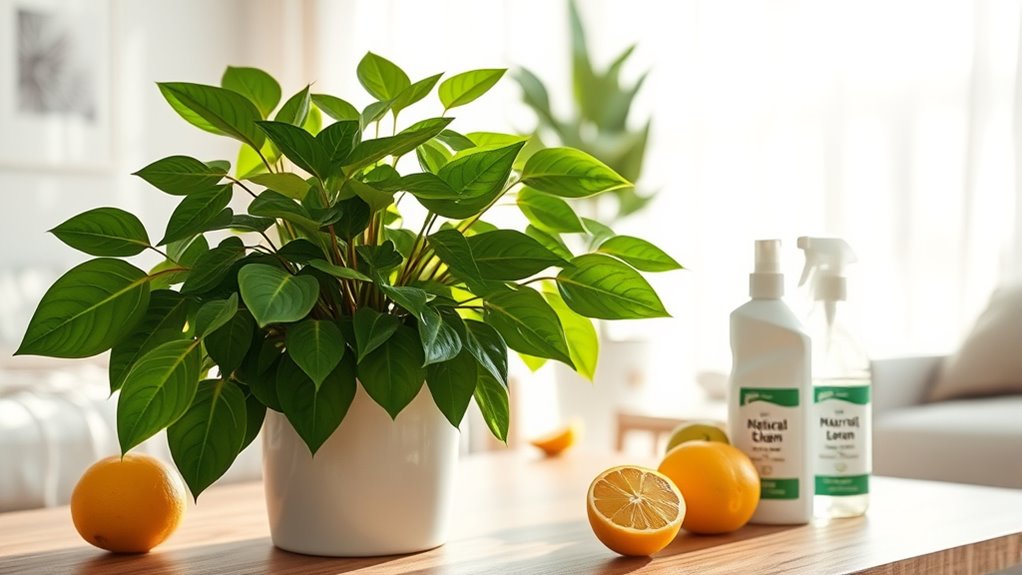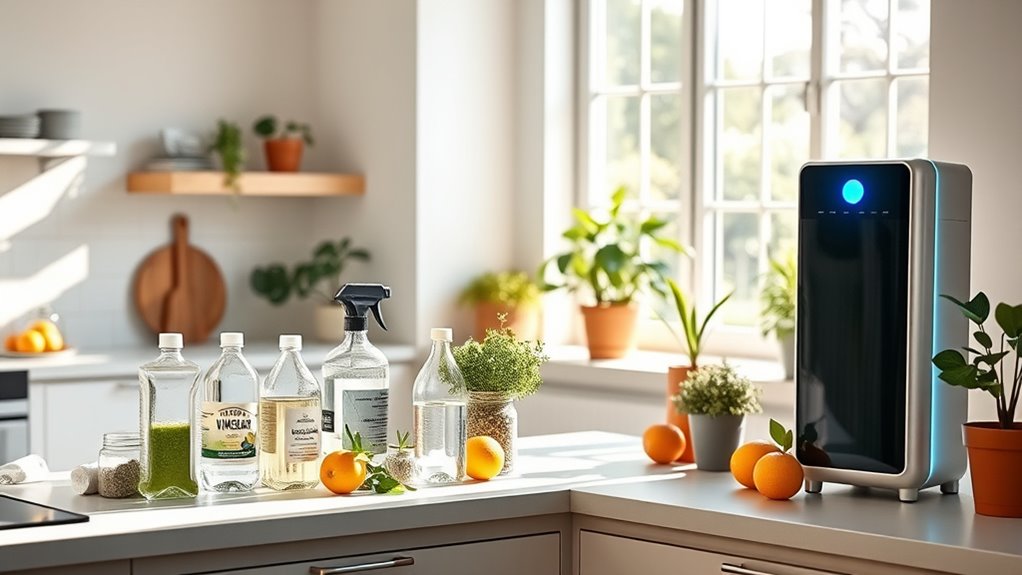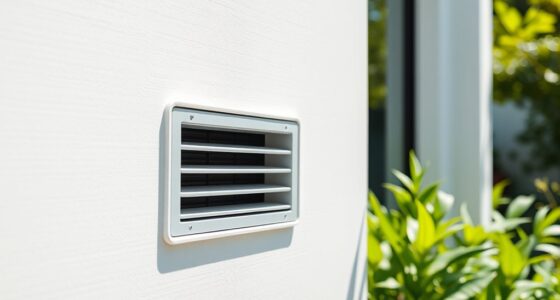To cut indoor VOCs today, open windows and use exhaust fans to boost ventilation, which naturally dilutes chemicals. Switch to natural cleaning products like vinegar and lemon juice, and choose low- or zero-VOC paints and furniture. Place houseplants such as snake plants or peace lilies to absorb VOCs naturally. Combine these simple steps with an air purifier that has a HEPA filter and activated carbon. Keep exploring for more easy, effective ways to improve your indoor air quality.
Key Takeaways
- Use air purifiers with HEPA filters and activated carbon to continuously remove VOCs from indoor air.
- Increase ventilation by opening windows and running exhaust fans to dilute indoor chemical concentrations.
- Incorporate houseplants like snake plants and peace lilies to naturally absorb VOCs.
- Switch to natural cleaning products and low-VOC paints to reduce chemical emissions at the source.
- Store chemicals properly and minimize their use to prevent indoor chemical buildup over time.

Have you ever wondered what’s lurking in the air inside your home? Many common household items release volatile organic compounds (VOCs), which can affect your health over time. These chemicals come from paints, cleaning supplies, furniture, and even some candles. While it’s impossible to eliminate every source, you can take practical steps to reduce VOC levels and improve indoor air quality. One effective approach is to use an air purifier. Look for models with HEPA filters and activated carbon layers, designed specifically to trap VOCs and other airborne pollutants. An air purifier can continuously remove these chemicals from your indoor environment, making the air safer to breathe, especially if you or your family members have allergies or respiratory issues.
However, relying solely on gadgets isn’t enough. You also have natural alternatives that can help cut down on indoor VOCs. For example, increasing ventilation by opening windows and using exhaust fans can considerably lower chemical concentrations. Fresh air dilutes VOCs and replaces stale indoor air, creating a healthier space. Additionally, you can incorporate houseplants known for their air-purifying qualities, such as snake plants, pothos, or peace lilies. These plants naturally absorb certain VOCs through their leaves and roots, helping to clean the air without the use of chemicals.
Switching to natural cleaning products is another smart move. Many conventional cleaners contain VOCs that linger in the air long after you’ve finished cleaning. Instead, opt for vinegar, baking soda, or lemon juice, which are effective and free from harmful chemicals. When shopping for paints or furniture, choose low-VOC or zero-VOC options. These products emit fewer chemicals during and after application, reducing your exposure over time.
You can also minimize VOCs by being mindful of the products you bring into your home. Regularly read labels and avoid items with strong chemical odors. Store chemicals in well-ventilated areas or outside your living space whenever possible. By combining these natural alternatives with technological solutions like air purifiers, you create a multi-layered defense against indoor VOCs. This proactive approach doesn’t require drastic changes, just mindful choices that gradually improve your home’s air quality.
In essence, reducing VOCs at home is about making smarter, healthier choices every day. With a little effort—using air purifiers, embracing natural alternatives, and maintaining good ventilation—you can markedly cut down on harmful chemicals and breathe easier in your own space.
Frequently Asked Questions
Are VOC Levels Higher During Specific Seasons or Weather Conditions?
VOCs levels can be higher during certain seasons due to seasonal variations and weather influence. In colder months, you might notice increased VOCs because windows stay shut longer, trapping chemicals indoors. Conversely, during warm, windy weather, open windows help ventilate your space, reducing VOC buildup. Humidity and temperature changes also impact VOC concentrations, so understanding these seasonal patterns helps you manage indoor air quality more effectively.
Can Pets Be Affected by Indoor VOCS?
Imagine your pet as a tiny detective sniffing out danger—VOCs at home can definitely affect them. Pet exposure to indoor VOCs may lead to health implications like respiratory issues or skin irritation. You might not notice it, but their sensitive noses pick up on these chemicals, risking long-term health. Protect your furry friends by improving ventilation and choosing low-VOC products, because their wellbeing depends on your actions.
How Long Do VOCS Typically Stay in Indoor Air?
VOCs typically stay in indoor air for a few hours to several days, depending on VOC persistence and air exchange rates. If your home has good ventilation, VOCs clear out faster, usually within a day or two. Poor air exchange can cause them to linger longer, sometimes for a week or more. To reduce VOC levels, increase air exchange by opening windows and using exhaust fans regularly.
Are There Any Natural or DIY Methods to Reduce VOCS?
Yes, you can use natural remedies and DIY solutions to reduce VOCs indoors. Ventilate your space regularly by opening windows and using fans to disperse chemicals. Houseplants like aloe vera and snake plants can absorb some VOCs naturally. Additionally, make your own air purifiers with activated charcoal or baking soda placed in open bowls around your home. These simple DIY solutions help improve air quality without harsh chemicals.
What Are the Long-Term Health Effects of Low-Level VOC Exposure?
You might not notice it, but prolonged low-level VOC exposure can subtly impact your health over time. It may weaken your immune response and contribute to chronic health issues like respiratory problems or allergies. While the effects aren’t always immediate, consistent exposure can gradually increase risks. Protect yourself by improving ventilation and reducing VOC sources, helping your body maintain resilience against these invisible, long-term threats.
Conclusion
Think of your home as a garden. Just as you’d prune and water your plants to keep them healthy, you need to tend to your indoor air. By reducing VOCs, you’re nurturing a safe, vibrant space where you can breathe easy. Every small step is like trimming a leaf—making a big difference over time. Take control today, and watch your home flourish into a sanctuary free from harmful chemicals.









